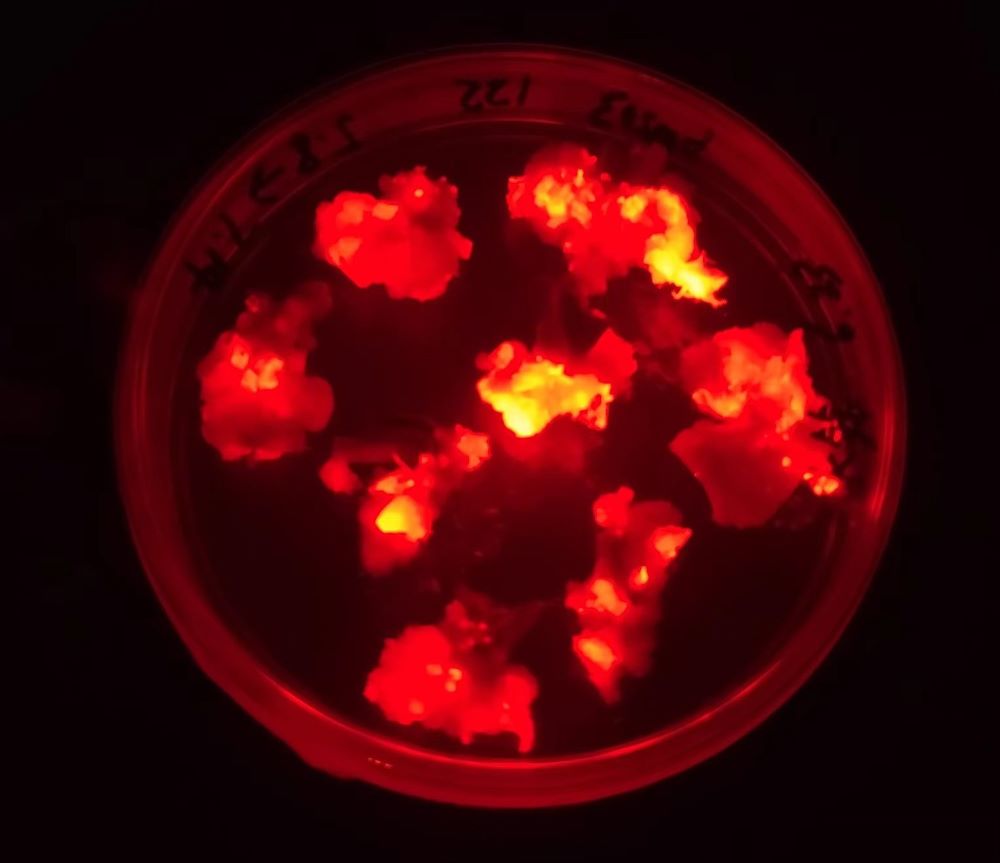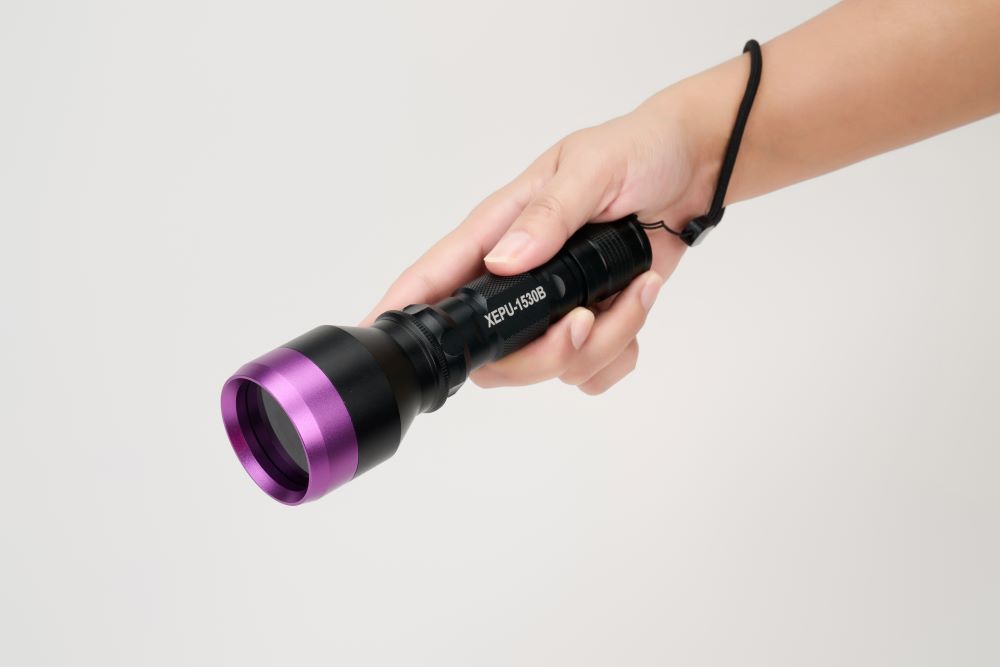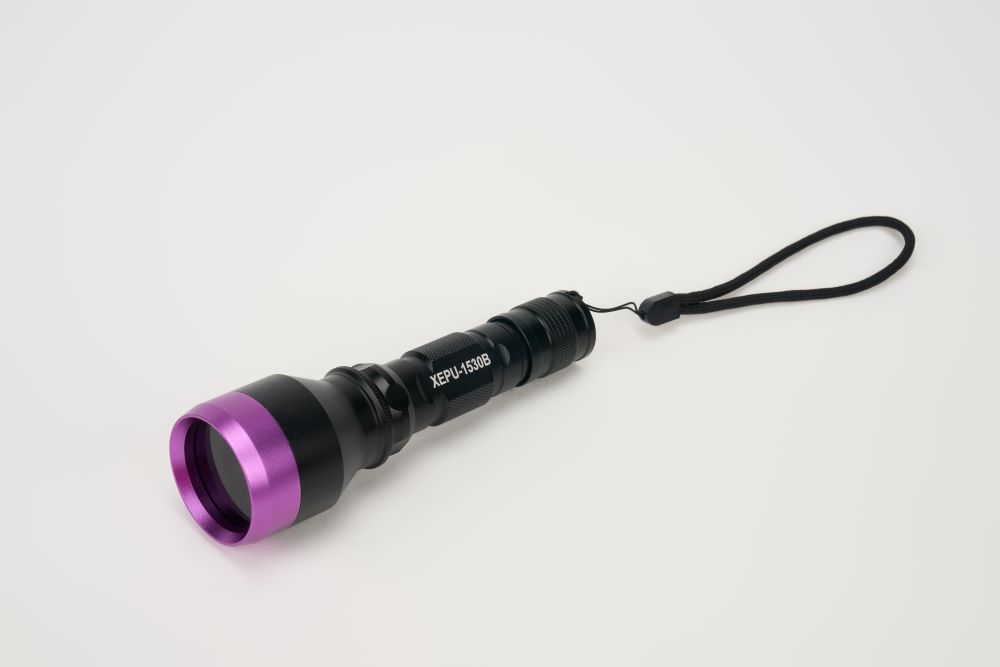Which GFPfinder excitation and emission combination should I use for my fluorophore (GFP, FITC, RFP…)?
The XEPU GFPfinder Flashlights offer five different fluorescence excitation wavelengths, which can be used to excite a wide range of fluorophores. This page provides guidance on selecting the right wavelength set for your application.
The table below lists the GFPfinder wavelength sets, including the most intense part of the excitation range and the cutoffs of the paired emission filters.
Our recommendations are based on either working knowledge with that fluorophore – our own or feedback from customers – or on published spectral data.
| Designation | Excitation | Emission |
| UV– Ultraviolet | 360 – 380nm | 415nm longpass |
| VI– Violet | 400 – 415nm | 450nm longpass |
| RB– Royal Blue | 440 – 460nm | 500nm longpass |
| RB– Royal Blue | 440 – 460nm | 500 – 560nm bandpass |
| CY– Cyan | 490 – 515nm | 550nm longpass |
| GR– Green | 510 – 540nm | 600nm longpass |
In A. victoria, GFP fluorescence occurs when aequorin interacts with Ca2+ ions, inducing a blue glow. Some of this luminescent energy is transferred to the GFP, shifting the overall color towards green.
The Green Fluorescent Protein (GFP) is a versatile biological marker for monitoring physiological processes, visualizing protein localization, and detecting transgenic expression in vivo. GFP can be excited by the 488 nm Fluorescence Flashlight GRPfinder and is optimally detected at 510 nm.
Why does GFP glow under UV light?
Solutions of purified GFP look yellow under typical room lights, but when taken outdoors in sunlight, they glow with a bright green color. The protein absorbs ultraviolet light from the sunlight, and then emits it as lower-energy green light.
Figure below: GFP expression under Fluorescence Flashlight

What is the emission wavelength of DsRed?
DsRed is a fluorescent compound with an excitation peak at 559 nm and an emission peak at 583 nm.
DsRed a.k.a. drFP583, discRFP, RFP, DsRed1.DsRed is a basic (constitutively fluorescent) red fluorescent protein published in 1999, derived from Discosoma sp..
Figure below: DsRed fluorescence expression under Fluorescence Flashlight GFPfinder-2101GR

The ultraviolet flaw detection lamp uses a filter to filter out the visible light, and the output is long-wave ultraviolet light. Long-wave ultraviolet rays are not within the range of human eyes, so the ultraviolet lamp used for flaw detection is usually called black light lamp.
The ultraviolet flaw detection lamp used in fluorescent magnetic particle inspection and fluorescent penetrate inspection is a non-destructive testing (NDT) method. It is mainly used for metal surface inspection to detect cracks and defects on the material surface. Common styles of ultraviolet flaw detection lamps include flashlights and portable lamps.
Figure below: UV Flaw Detection Flashlight XEPU-1530B

For NDT professionals who want to use UV technology developed exclusively for non-destructive testing, XEPU UV lamps and LED UV lamps for non-destructive examinations will help you find indications faster and more reliably.
XEPU Handheld LED UV NDT Flashlights are mainly used in industrial detection, including Fluorescent Penetrate Testing, Fluorescent Magnetic Particle Flaw Detection and Fluorescent Leak Detection.
Other Applications include oil and stain detection, special gas, oil and gas pipeline inspection, fluorescence reflectance detection of special substances, criminal investigation and forensic investigation, paper currency identification, gem appreciation, agriculture, food, medical and other related industries.
UV NDT Flashlight, Handheld UV Lamp, Portable UV Lamps
What issues should we pay attention to when using UV flaw detection lamps?
1. When using UV detection lights, avoid direct exposure to eyes and skin to prevent eye and skin damage.
2. When using UV lamps, indoor air circulation should be ensured and protection should be taken. At the same time, avoid prolonged exposure to ultraviolet rays to avoid harm to your health.
3. UV Flaw detection lights and accessories should be used or stored in a clean, dry, and non-corrosive environment.
4. If there is dirt on the filter, it should be removed in time because it will affect the emission of black light.
5. If the filter has cracks, it should be replaced in time, because cracks will allow visible light and medium and short-wave ultraviolet light to pass.
6. During the use of the UV lamp, if you find that the lamp does not light up or flickers, you should stop using it immediately and check whether the flaw detection lamp has poor contact or whether the lithium battery is insufficiently charged.
Figure below: High-Intensity UV Detection Flashlight XEPU-1530B

